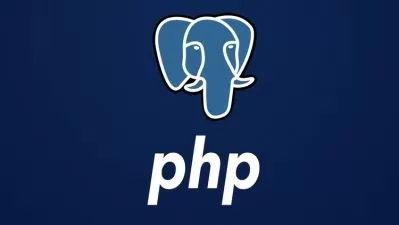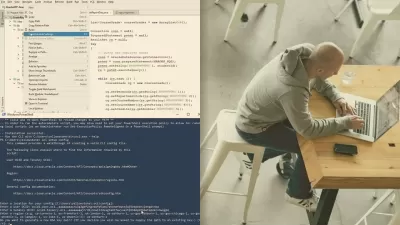Perl Programming: Understanding The Basics [2024]
Valters S
7:19:24
Description
Mastering Perl: Fundamentals, Unit Testing, Mouse OOP and DBIx ORM Frameworks
What You'll Learn?
- Understand Perl data structures, subroutines, regular expressions and more.
- Install and manage Perl dependencies using CPANM.
- Learn how to write Perl scripts and modules.
- Read and write files using native Perl and modules.
- Import Perl code from external script files.
- Understand Perl data structure references.
- Run system commands using Perl.
- Execute Perl via command line interface.
- Understand variables scope in Perl.
- Debug your Perl code and understand error messages.
- Write object-oriented Perl code using Perl's out of the box OOP solution.
- Learn fundamentals of Mouse OOP framework.
- Learn fundamentals of DBIx ORM framework.
- Unit test Perl code.
- Installing Perl on Windows, Ubuntu Mac OS and Linux.
- Use Docker to run your Perl code.
Who is this for?
What You Need to Know?
More details
DescriptionUnlock the power of Perl programming with our comprehensive course designed for beginners and intermediate programmers. Dive into the essentials of Perl, from basic syntax to advanced features, and gain a solid foundation in this versatile language.
Learn how to write clean, efficient, and maintainable code by mastering the fundamentals of unit testing in Perl.
Explore the Mouse Object-Oriented Programming (OOP) framework to create scalable and well-structured applications. This lightweight yet powerful framework will help you implement OOP principles effectively in your Perl projects.
Master Perl's DBIx ORM framework, designed to streamline your database interactions and boost your coding efficiency.
By the end of this course, you'll be equipped with the skills to build, test, and maintain Perl applications with confidence. Whether you're starting your programming journey or looking to enhance your Perl expertise, this course is your gateway to becoming a proficient Perl developer.
Why Learn Perl in 2024?
Perl remains a powerful and versatile language in 2024, offering unique advantages for modern programming challenges. Its strong text-processing capabilities make it ideal for tasks involving data manipulation, web scraping, and system administration. Perl's comprehensive CPAN library provides a vast array of modules, saving time and effort in development. With its robust support for regular expressions and efficient scripting, Perl is perfect for rapid prototyping and automation.
Additionally, learning Perl enhances your problem-solving skills and broadens your programming toolkit. As many legacy systems and established companies still rely on Perl, mastering it can open doors to specialised job opportunities and career growth. Embrace the power of Perl and stay ahead in the ever-evolving tech landscape.
Is This Course for You?
Absolutely! This course is perfect for you if:
Beginners: You're new to programming and want to start with a language known for its versatility and powerful text-processing capabilities.
Intermediate Programmers: You have some coding experience and want to expand your skill set with Perl, a versatile and efficient scripting language.
System Administrators: You need to automate tasks, manage files, and handle system operations efficiently using Perl.
Data Analysts: You’re looking to leverage Perl's strong text-manipulation and data-parsing abilities to streamline your workflows.
Students and Hobbyists: You have a keen interest in learning a new programming language that is both practical and fun.
What Will This Course Teach Me?
In this course, you will gain a comprehensive understanding of Perl programming and its practical applications. You will learn:
Perl Fundamentals: Grasp the core concepts of Perl, including syntax, data structures, regular expressions, and file handling.
Object-Oriented Programming (OOP): Understand the principles of OOP and how to implement them in Perl to create modular and reusable code.
Object-Relational Mapping (ORM): Understand the principles of ORM and how to implement them in Perl to create modular and reusable code to interact with your database.
Unit Testing: Master the techniques of unit testing in Perl to ensure your code is reliable, maintainable, and bug-free.
Mouse OOP Framework: Dive into the Mouse OOP framework, a lightweight yet powerful tool, to build scalable and well-structured applications.
By the end of this course, you'll be equipped to write efficient Perl scripts, design robust object-oriented programs, and implement comprehensive unit tests, all while leveraging the power of the Mouse framework.
About The Instructor
I am a passionate Senior Backend Developer and API Team Lead with a BSc degree in Computer Science. My journey began with a fascination for understanding how computers work, evolving from creating basic web templates in HTML, CSS, and JavaScript to mastering complex backend technologies.
I specialise in building large-scale Perl applications using frameworks like Mojolicious, Mouse, and DBIx, handling thousands of requests per second. My expertise extends to AWS services (e.g., EC2, Cognito, API Gateway, Lambda), Docker, MySQL/PostgreSQL, OpenAPI, RabbitMQ, and caching solutions such as Redis and Memcached. My diverse skill set and dedication drive my continuous enthusiasm for backend development.
Who this course is for:
- This course is ideal for beginners with little or no prior experience writing Perl code.
- This course is aimed to cover fundamentals of Perl programming.
Unlock the power of Perl programming with our comprehensive course designed for beginners and intermediate programmers. Dive into the essentials of Perl, from basic syntax to advanced features, and gain a solid foundation in this versatile language.
Learn how to write clean, efficient, and maintainable code by mastering the fundamentals of unit testing in Perl.
Explore the Mouse Object-Oriented Programming (OOP) framework to create scalable and well-structured applications. This lightweight yet powerful framework will help you implement OOP principles effectively in your Perl projects.
Master Perl's DBIx ORM framework, designed to streamline your database interactions and boost your coding efficiency.
By the end of this course, you'll be equipped with the skills to build, test, and maintain Perl applications with confidence. Whether you're starting your programming journey or looking to enhance your Perl expertise, this course is your gateway to becoming a proficient Perl developer.
Why Learn Perl in 2024?
Perl remains a powerful and versatile language in 2024, offering unique advantages for modern programming challenges. Its strong text-processing capabilities make it ideal for tasks involving data manipulation, web scraping, and system administration. Perl's comprehensive CPAN library provides a vast array of modules, saving time and effort in development. With its robust support for regular expressions and efficient scripting, Perl is perfect for rapid prototyping and automation.
Additionally, learning Perl enhances your problem-solving skills and broadens your programming toolkit. As many legacy systems and established companies still rely on Perl, mastering it can open doors to specialised job opportunities and career growth. Embrace the power of Perl and stay ahead in the ever-evolving tech landscape.
Is This Course for You?
Absolutely! This course is perfect for you if:
Beginners: You're new to programming and want to start with a language known for its versatility and powerful text-processing capabilities.
Intermediate Programmers: You have some coding experience and want to expand your skill set with Perl, a versatile and efficient scripting language.
System Administrators: You need to automate tasks, manage files, and handle system operations efficiently using Perl.
Data Analysts: You’re looking to leverage Perl's strong text-manipulation and data-parsing abilities to streamline your workflows.
Students and Hobbyists: You have a keen interest in learning a new programming language that is both practical and fun.
What Will This Course Teach Me?
In this course, you will gain a comprehensive understanding of Perl programming and its practical applications. You will learn:
Perl Fundamentals: Grasp the core concepts of Perl, including syntax, data structures, regular expressions, and file handling.
Object-Oriented Programming (OOP): Understand the principles of OOP and how to implement them in Perl to create modular and reusable code.
Object-Relational Mapping (ORM): Understand the principles of ORM and how to implement them in Perl to create modular and reusable code to interact with your database.
Unit Testing: Master the techniques of unit testing in Perl to ensure your code is reliable, maintainable, and bug-free.
Mouse OOP Framework: Dive into the Mouse OOP framework, a lightweight yet powerful tool, to build scalable and well-structured applications.
By the end of this course, you'll be equipped to write efficient Perl scripts, design robust object-oriented programs, and implement comprehensive unit tests, all while leveraging the power of the Mouse framework.
About The Instructor
I am a passionate Senior Backend Developer and API Team Lead with a BSc degree in Computer Science. My journey began with a fascination for understanding how computers work, evolving from creating basic web templates in HTML, CSS, and JavaScript to mastering complex backend technologies.
I specialise in building large-scale Perl applications using frameworks like Mojolicious, Mouse, and DBIx, handling thousands of requests per second. My expertise extends to AWS services (e.g., EC2, Cognito, API Gateway, Lambda), Docker, MySQL/PostgreSQL, OpenAPI, RabbitMQ, and caching solutions such as Redis and Memcached. My diverse skill set and dedication drive my continuous enthusiasm for backend development.
Who this course is for:
- This course is ideal for beginners with little or no prior experience writing Perl code.
- This course is aimed to cover fundamentals of Perl programming.
User Reviews
Rating
Valters S
Instructor's Courses
Udemy
View courses Udemy- language english
- Training sessions 55
- duration 7:19:24
- Release Date 2024/08/12

















